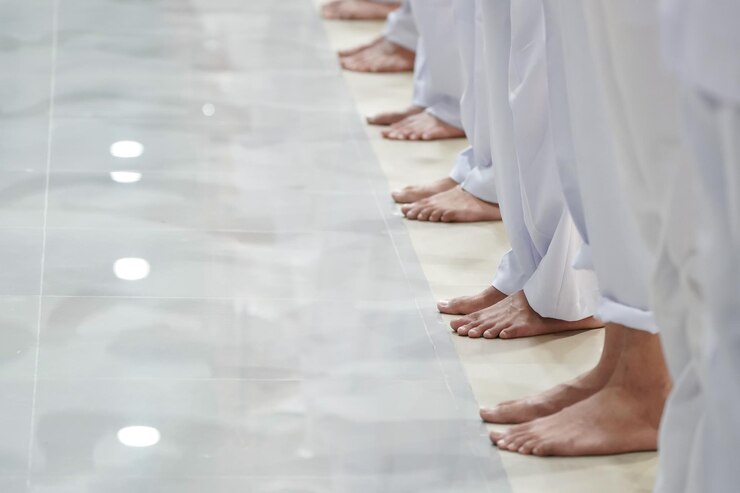
Informative
Why Do Asians Remain Barefoot Most Times?
The earliest archaeological evidence of footwear in India comes from the Indus Valley Civilization, which existed between 2600 BCE and 1900 BCE. Excavations at Harappa and Mohenjo-Daro, two major cities of this civilization, have revealed a variety of shoes and sandals made of leather and other materials.
So, even though using footwear was such an integral part of this ancient civilization, why do people, especially the followers of Hinduism, Buddhism, and Islam, leave their shoes and sandals outside the temples? Even when entering the house, many people from Asian countries enter the house only after removing their shoes. Because walking barefoot has its own unique significance in spirituality, and in this blog, we are going to learn about it. Let’s begin.
Earth and its Significance in Spirituality
Our spiritual connection with the earth is a concept that has been recognized by many cultures and spiritual traditions throughout history. This connection is based on the idea that we are not separate from nature but rather a part of it and that our spiritual well-being is intertwined with the health and vitality of the earth.
Many spiritual traditions view the earth as a sacred entity and believe that we have a responsibility to care for and protect it. This can be seen in practices such as ritual offerings, prayer, and meditation, which are used to honor the earth and express gratitude for the gifts it provides.
The earth is often referred to as “Bhumi Devi” or “Prithvi Mata” in Hinduism and is seen as a nurturing mother who provides sustenance and life to all living beings. In many Hindu rituals, the earth is worshiped as a goddess, and offerings are made to her in the form of water, flowers, and other offerings.
The earth is seen as the foundation of righteousness and the embodiment of Dharma, the universal law of righteousness and order. According to Sanatana Dharma, the earth was created by Lord Brahma, the creator of the universe, to provide a place for human beings to live and fulfill their Dharma. So, wearing shoes, especially in sacred places like temples and pilgrimage sites, is believed to be disconnecting yourself from this divine connection.
In India, removing shoes before entering a temple is a common practice in Hinduism.
There are several reasons behind this tradition.
Purity:
The temple is considered a sacred place where devotees come to worship and seek blessings from the deity. It is believed that the temple is a pure and holy place, and removing shoes before entering is a way to maintain the sanctity of the space.
Hygiene:
Removing shoes before entering the temple helps to keep the floors clean and prevents dirt and dust from outside from entering the sacred space. This also makes it more comfortable for devotees to sit and perform their prayers on the floor.
Respect:
Removing shoes before entering the temple is a sign of respect for the deity and the space. It shows humility and devotion towards the divine and is considered an act of surrendering oneself to the divine presence.
Tradition:
The practice of removing shoes before entering the temple has been a part of Hindu tradition for centuries and is passed down from generation to generation. Most temples have turmeric, sandalwood, and sindoor on their floors, which are believed to have health benefits, according to Ayurveda. When we walk on the temple floor without shoes, we can absorb these benefits, which can help improve our physical and mental health.
The design of the temple is important for why people go inside without shoes. The temple is built in a location that helps increase positive energy. When we walk inside without shoes, our bodies can absorb this positive energy. The temple also helps keep away negative energy. If we wear shoes, the flow of energy is blocked. When we go inside without shoes, a clear pathway for positive energy opens up.
Feet and Chakras
According to some spiritual traditions, walking barefoot can be connected to the body’s chakras or energy centers. The chakras are believed to be located along the spine and are associated with different aspects of physical and emotional well-being.
In some traditions, it is believed that the soles of the feet are connected to the first or root chakra, which is associated with grounding and stability. Walking barefoot can help activate and balance this chakra, allowing us to feel more connected to the earth and more centered in our physical bodies.
Additionally, walking barefoot is believed to help activate the second or sacral chakra, which is associated with creativity and passion. This is because the feet have many nerve endings and reflex points that are connected to the entire body, and stimulating these points can help increase energy flow throughout the body.
Overall, our spiritual connection with the earth is a reminder of our interconnectedness with all living things and the importance of living in harmony with nature. The practice of walking barefoot is a way of showing respect, honoring sacredness, and establishing a more profound connection with mother earth.
Please subscribe to our mailing list to stay connected and receive spiritual information.
In case of any queries, please write to us at info@chamundaswamiji.com. You can check out our YouTube channel Chamunda Swamiji where you can learn Tantra, Mantra, Yantra, and Meditation from His Holiness Shri Chamunda Swamiji. If you seek to learn Shakti Kriya, please register with us, and we will get back to you.
Post a Comment
-
Subscribe to Our Blog
-
Categories
-
Popular Articles
- Dead moth in the house. What universe is trying to tell you?
- Spiritual Meaning of Moth
- Vivah Bandhan Curse – What Is It and How to Spiritually Heal It.
- The Dasa Mahavidyas
- What are Beej Mantras?
- Tripura Sundari | The Dasa Mahavidya
- Maa Bhuvaneshwari | The Dasa Mahavidyas
- The Five Shades of Tantra
- Ramakrishna Paramhansa – The Man who almost became a Woman
- Maa Chinnamasta | The Dasa Mahavidyas



